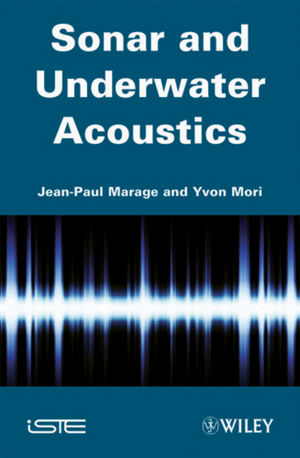Sonar and Underwater AcousticsISBN: 978-1-84821-189-6
Hardcover
608 pages
August 2010, Wiley-ISTE
 |
||||||
Preface ix
PART 1. THE MARINE ENVIRONMENT 1
Part 1. Introduction 3
Chapter 1. Problematics 5
1.1. History 5
1.2. Underwater acoustics 7
1.3. Applications 9
1.4. Comparison with radar 10
1.5. Submarine detection and warfare 11
1.6. Submarine detection 11
1.7. Submarine detection: a veritable challenge 12
1.8. Overcoming the effects of the ocean 13
1.9. Sonar and information processing 16
Chapter 2. Sound Propagation in the Marine Environment 19
2.1. General points 19
2.2. Characteristics of the marine environment 19
2.3. Models used 22
2.4. Propagation phenomena 28
2.5. Application examples 33
Chapter 3. Noises and Reverberation 41
3.1. Classification of ambient noises 41
3.2. Analysis of noise sources 45
3.3. Wenz’ model of sea noise 51
3.4. Directivity of sea noise 52
3.5. Reverberation 55
Chapter 4. Radiated and Inherent Noises 65
4.1. Radiated noise 65
Chapter 5. Transmission of the Acoustic Signal: Sonar Equations 79
5.1. Introduction 79
5.2. Detection contrast and detection index 80
5.3. Transmission equation 81
5.4. Equation of passive sonar 88
5.5. Equation of active sonar 89
PART 2. ACOUSTIC-ELECTRIC INTERFACE ANTENNA STRUCTURES 93
Part 2. Introduction 95
Chapter 6. Electric-acoustic and Acoustic-electric Transformations 97
6.1. Transducers and hydrophones 97
Chapter 7. Performance and Structures of Acoustic Antennas 113
7.1. Antennas and radiation 113
7.2. Structures of sources and antennas 189
Chapter 8. Electronic Transducer-hydrophone Adaptation 211
8.1. Hydrophones 211
8.2. Transducers 243
Chapter 9. Electro-mechano-acoustic Analogies 269
9.1. Methods of studying transducers and hydrophones 269
9.2. Mechanic-electric equivalence 270
9.3. Electric-acoustic equivalence 275
9.4. Finite element method (FEM) 320
PART 3. PROCESSING CHAIN OF ACTIVE SONAR 323
Part 3. Introduction 325
Chapter 10. Selection Criteria in Active Processing 327
10.1. Selection criteria related to propagation 327
10.2. Selection criteria relative to noise 331
10.3. Selection criteria related to reverberation 332
10.4. Selection criteria related to emission power 333
10.5. Selection criteria related to the antenna 335
10.6. Selection criteria for the operating frequency 336
10.7. Selection criteria related to operational considerations 337
10.8. Selection criteria related to the nature of targets 337
Chapter 11. Processing Chain in Active Sonar 341
11.1. General points 341
11.2. Emission 341
11.3. Reception 345
Chapter 12. Basic Theoretical Notions in Active Processing 459
12.1. The Doppler effect 459
12.2. The Doppler effect in active sonar conditions 464
12.3. Treatment of the signal 485
12.4. Choice of an emission signal under active sonar conditions 503
Chapter 13. Measurement in Underwater Acoustics 525
13.1. Introduction 525
13.2. Wave train method 531
13.3. Precautions before measuring 539
13.4. Acoustic measurements and calibrations of transducers 542
13.5. Notion of uncertainty estimation and of maximum tolerated difference 551
13.6. Other types of measurements in underwater acoustics 553
APPENDICES 555
Appendix 1. Logarithmic Scales 557
Appendix 2. Equation of Sound in Fluids 563
Appendix 3. Piezoelectricity Fundamentals 571
Appendix 4. Vector Analysis ?Ï?nFundamentals 579
Appendix 5. Reciprocity Theorem 593
Appendix 6. Concrete Example of Uncertainty Estimation Based on the Reciprocity Calibration Method 601
Bibliography 619
Index 623



